Peter Pan (1953 film)
7.4 /10 1 Votes
75% Rotten Tomatoes Genre Animation, Adventure, Family Duration Language English | 7.4/10 IMDb Initial DVD release March 6, 2007 Country United States | |||||||||||||||||||||||||||||||||
 | ||||||||||||||||||||||||||||||||||
Director Clyde GeronimiWilfred JacksonHamilton Luske Release date February 5, 1953 (1953-02-05) (US) Writer J.M. Barrie (play), Ted Sears (story), Erdman Penner (story), Bill Peet (story), Winston Hibler (story), Joe Rinaldi (story), Milt Banta (story), Ralph Wright (story), William Cottrell (story) Songs Main Title (Second Star to the Right) / All This Has Happened Before Cast (Peter Pan (voice)), (Wendy Darling (voice)), (Captain Hook / Mr. Darling (voice)), (Mr. Smee (voice)), (Mrs. Darling (voice)), (John Darling (voice)) Similar movies , The Little Mermaid , Pinocchio , The Nightmare Before Christmas , Cinderella , Tagline It will live in your heart forever! | ||||||||||||||||||||||||||||||||||
Peter Pan is a 1953 American animated adventure film produced by Walt Disney and based on the play Peter Pan, or The Boy Who Wouldn't Grow Up by J. M. Barrie. It is the 14th Disney animated feature film and was originally released on February 5, 1953, by RKO Radio Pictures. Peter Pan is the final Disney animated feature released through RKO before Walt Disney's founding of his own distribution company, Buena Vista Distribution, later in 1953 after the film was released. Peter Pan is also the final Disney film in which all nine members of Disney's Nine Old Men worked together as directing animators. It is also the second Disney animated film starring Kathryn Beaumont, Heather Angel, and Bill Thompson after their roles in the animated feature Alice in Wonderland.
Contents
- Plot
- Cast and characters
- Production
- Live action reference
- Character animation
- Music
- Songs
- Music releases
- Release
- Home video release
- Critical reaction
- Controversy
- Box office
- Disney Fairies
- Theme parks
- Ice shows
- Video games
- Board game
- Musical
- Sequels
- Live action remake
- References
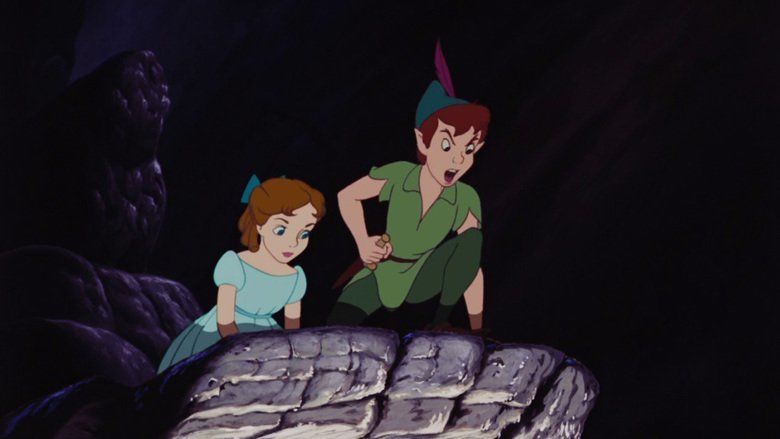
The film was entered into the 1953 Cannes Film Festival. A sequel titled Return to Never Land was released in 2002, and a series of direct-to-DVD prequels produced by DisneyToon Studios focusing on Tinker Bell began in 2008.
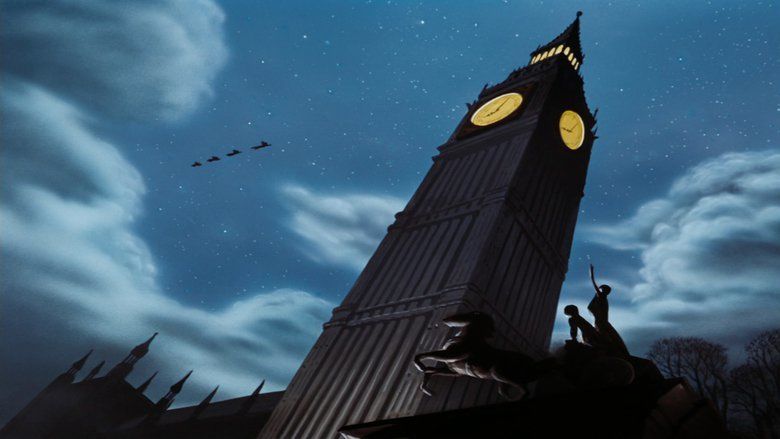
Plot
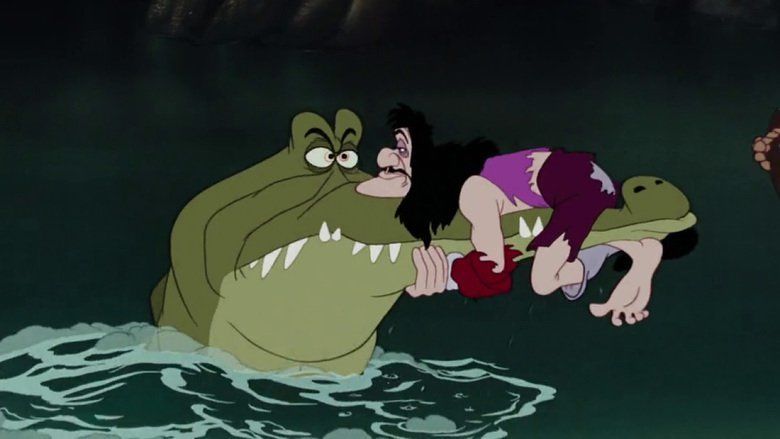
Set in London, circa 1900, George and Mary Darling's preparations to attend a party are disrupted by the antics of their boys, John and Michael, acting out a story about Peter Pan and the pirates, told to them by their older sister, Wendy. Their father, who is fed up with the stories that have made his children less practical, angrily declares that Wendy has gotten too old to continue staying in the nursery with them. That night, they are visited in the nursery by Peter Pan himself, who teaches them to fly with the help of his pixie friend, Tinker Bell, and takes them with him to the island of Never Land.
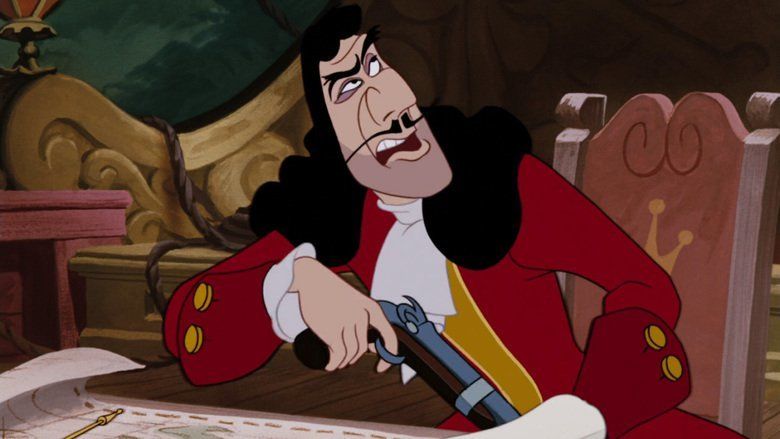
A ship of pirates is anchored off Never Land, commanded by Captain Hook with his sidekick, Mr. Smee. Hook boldly plots to take revenge upon Peter Pan for cutting off his hand, but trembles at the presence of a crocodile, which consumed Hook’s hand and is eager to taste the rest of him. The crew's restlessness is interrupted by the arrival of Peter and the Darlings. Tinker Bell, who is very jealous of Pan’s attention to Wendy, persuades the Lost Boys that Pan has ordered them to shoot down Wendy, which Tink refers to as a “Wendy bird”. Tinker Bell's treachery is soon found out, and Peter banishes her. John and Michael set off with the Lost Boys to find the island's Indians, who instead capture them, believing them to be the ones responsible for taking the chief's daughter, Tiger Lily.
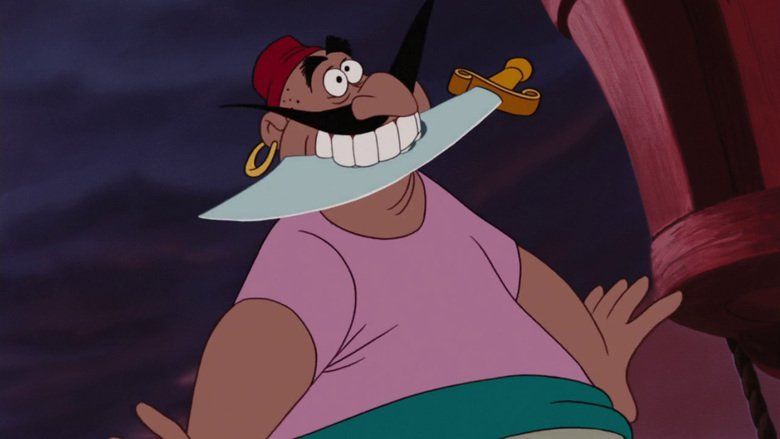
Meanwhile, Peter takes Wendy to see the mermaids. The mischievous mermaids delight in tormenting Wendy but flee in terror at the sight of Hook. Peter and Wendy see that Hook and Smee have captured Tiger Lily so that they might persuade her to disclose Peter's hideout. Peter and Wendy free her, and Peter is honored by the tribe. Hook then plots to take advantage of Tinker Bell's jealousy of Wendy, tricking her into revealing the location of Peter's lair. Wendy and her brothers eventually grow homesick and plan to return home. They invite Peter and the Lost Boys to return to London and be adopted by the Darling parents. The Lost Boys agree, but Peter is so set against growing up that he refuses, presumptuously thinking that they will all return shortly. The pirates lie in wait and capture the Lost Boys and the Darlings as they exit, leaving behind a time bomb to kill Peter. Tinker Bell learns of the plot just in time to snatch the bomb from Peter as it explodes.
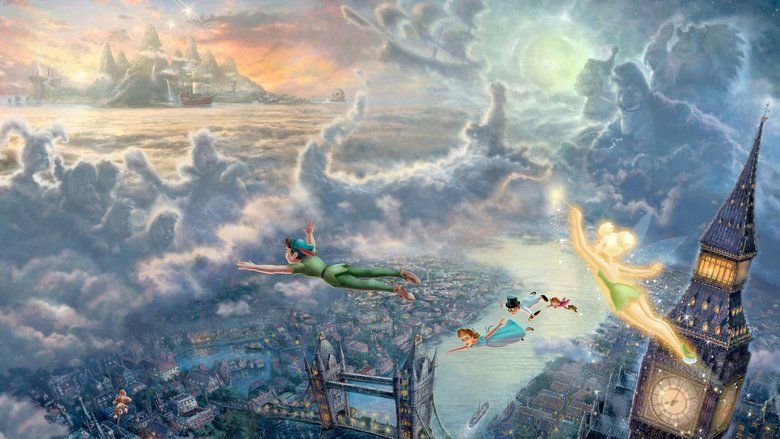
Peter rescues Tinker Bell from the rubble and together they confront the pirates, releasing the children before they can walk the plank. Peter engages Hook in single combat as the children fight off the crew, and finally succeeds in humiliating the captain. Hook and his crew flee, with the crocodile in hot pursuit. Peter gallantly commandeers the deserted ship, and assisted by Tinker Bell's pixie dust, flies it to London with the children aboard. However, the Lost Boys decide to return to Never Land rather than be adopted in London. Mr. and Mrs. Darling return home from the party to find Wendy not in her bed, but sleeping at the open window. Wendy awakens and excitedly tells about their adventures. The parents look out the window and see what appears to be a pirate ship in the clouds. Mr. Darling, who has softened his position about Wendy staying in the nursery, recognizes it from his own childhood.
Cast and characters

Production
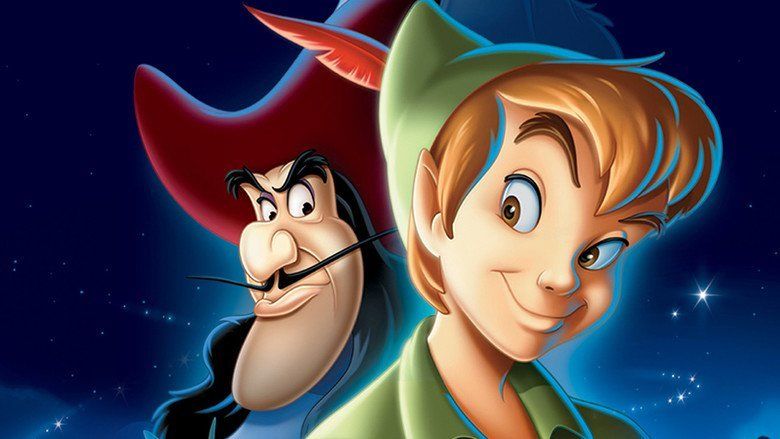
In 1935, Walt Disney expressed interest in doing an adaptation of Peter Pan as his second film following Snow White and the Seven Dwarfs. However, the live-action film rights were held by Paramount Pictures, in which the copyright owner, the Hospital for Sick Children in London, offered to have Disney make an agreement with Paramount that proved to be unsuccessful. However, in January 1939, Disney obtained the animation rights to the play outbidding the Fleischer Studios who were also developing of animated feature films. By early 1939, a storyreel had been completed, and by the following May, Disney had several animators in mind for the characters. Vladimir Tytla was considered for the pirates, Norman Ferguson for the dog, Nana, (who also animated Pluto), and Fred Moore for Tinker Bell.
During this time, Disney explored many possibilities of how the story could be interpreted. In the earliest version of the story, the film started by telling Peter Pan's back story. But on May 20, 1940, during a story meeting, Disney said "We ought to get right into the story itself, where Peter Pan comes to the house to get his shadow. That's where the story picks up. How Peter came to be is really another story." Walt also explored the idea of opening the film in Neverland and Peter Pan coming to Wendy's house to kidnap her as a mother for the Lost Boys. Eventually, Disney decided that the "kidnapping" was too dark and went back to Barrie's original play where Peter comes to get his shadow and Wendy is eager to see Neverland.
Following the bombing of Pearl Harbor on December 7, 1941, the United States military took control of the studio and commissioned Walt Disney Productions to produce training and war propaganda films in which pre-production work on Peter Pan and Alice in Wonderland were shelved. However, the Bank of America allowed production to continue during the war. After the war had concluded, work on the film resumed with Jack Kinney as director. At the time, Kinney had considered leaving Walt Disney Productions for the Metro-Goldwyn-Mayer cartoon studio, but wartime restrictions prevented this. Because he did not want Kinney to get out of his contract, Disney appointed Kinney to direct Peter Pan.
During this same time, Disney talked to Mary Martin, who was appearing in a stage production of the play, about voicing Peter Pan, although Roy O. Disney complained that her voice was "too heavy, matured, and sophisticated." Jean Arthur contacted Walt about being considered for the role. Walt had also talked to Cary Grant about voicing Captain Hook, in which the actor replied the "idea intrigued him." As he was impatient with the delays, Disney asked Kinney to work on sequences consecutively rather than finish the entire script before it was storyboarded so that a scene would be approved at a morning story meeting and then immediately be put into development. Six months later, during a storyboarding meeting, Kinney presented a two-and-a-half presentation, in which Walt sat silently and stated, "You know, I've been thinking about Cinderella."
By 1947, Walt Disney Productions' financial health started to improve again. Around this time, Walt acknowledged the need for sound economic policies, but emphasized to the loaners that slashing production would be suicidal. In order to restore the studio to full financial health, he expressed his desire to return to producing full-length animated films. By then, three animated projects—Cinderella, Alice in Wonderland, and Peter Pan—were in development. Walt felt the characters in Alice in Wonderland and Peter Pan were too cold while Cinderella contained elements similar to Snow White and decided to greenlit the project. Peter Pan was placed back into production in May 1949.
The scene in the nursery went through many alterations. For instance in one version, it was Mrs. Darling who found Peter Pan's shadow and showed it to Mr. Darling as in the original play. In another version of the film, Nana went to Neverland with Pan and the Darling children, and the story was told through her eyes. In other interpretations of the story, John Darling was left behind for being too serious, practical and boring, but story artist Ralph Wright convinced Disney to have John go with the others to Never Land. The film also included Wendy taking her Peter Pan Picture Book" and Peter and the children eating an "Imaginary Dinner". At one point, there was a party in Peter's hideout where Tinker Bell got humiliated and in her rage went and deliberately told Captain Hook the location of Peter Pan's hideout at her own free will. However, Walt felt that this was against Tinker Bell's character and that she had "gone too far" and changed it to Captain Hook kidnapping and persuading Tinker Bell to tell him. There is a point in Barrie's play where Captain Hook puts poison in Peter's dose of medicine and Tinker Bell saves Peter by drinking the poison herself only to be revived by the applause by the theater audience. After much debate Disney discarded this fearing it would be difficult to achieve in a film. In earlier scripts, there were more scenes involving the Pirates and the Mermaids that were similar to what Disney had previously done with the dwarfs in Snow White and the Seven Dwarfs. Ultimately, these scenes were cut for pacing reasons. The film was also a little bit darker at one point since there were scenes involving Captain Hook being killed by the crocodile, the Darling family mourning over their lost children, and Pan and the children discovering the pirates' treasure which is loaded with booby traps.
Live-action reference
As with previous Disney animated features, a live-action version was filmed to serve as an aid to animators with the actors performing to a prerecorded dialogue track. Margaret Kerry received a call to audition to serve as the live-action reference for Tinker Bell. For the live-action reference, Kerry said she had to hold out her arms and pretend to fly for all the scenes requiring it. Additionally, Kerry served as reference for one of the mermaids along with Connie Hilton and June Foray. At the same time, the studio was looking for an actor to portray Peter Pan, in which Kerry suggested her dancing teacher Roland Dupree for the part. Dupree was interviewed and eventually won the role, in which he provided reference for the flying and action sequences. Bobby Driscoll also served as the live-action reference model for Peter Pan, although it was mainly used for the close-up scenes. Hans Conreid completed the voice work over the course of a few days, and served as the live-action reference for two-and-a-half years. Kathryn Beaumont, who was also the voice of Wendy, also performed for the live-action reference footage.
Character animation
Milt Kahl desired to animate Captain Hook, but was instead assigned to animate Peter Pan and the Darling children in which he claimed he was "outmaneuvered". During production, while animating Peter Pan, Kahl claimed that the hardest thing to animate was a character floating in mid-air. While observing the animation of Peter Pan, Disney complained that the animators let too much of Driscoll's facial features get into the character design. He told Kahl that "[t]hey are too masculine, too old. There is something wrong there." "You want to know what's wrong!?...What's wrong is that they don't have any talent in the place," Kahl replied.
The role of Captain Hook was instead assigned to Frank Thomas. The characterization of Hook proved to be conflicting as Thomas claimed story artist Ed Penner viewed him as "a very foppish, not strong, dandy-type, who loved all the finery. Kind of a con man. [Co-director Gerry] Geronimi saw him as an Ernest Torrence: a mean, heavy sort of character who used his hook menacingly." When Disney saw Thomas's first test scenes, he said, "Well, that last scene has something I like I think you're beginning to get him. I think we better wait and let Frank go on a little further." Because Thomas could not animate every scene of Hook, certain sequences were given to Wolfgang Reitherman who animated Hook's over-the-top scenes including when he tries to escape Tick-Tock the crocodile.
Ollie Johnston animated Mr. Smee. To best capture his comedic yet fear-ridden, sycophantic personality, Johnston used a variation of the Dwarf design from Snow White, and had Smee blink numerously. His former mentor, Fred Moore, worked in Johnston's unit as a character animator on minor scenes for Smee, as well as animated the mermaids and the Lost Boys. On November 22, 1952, both he and his second wife, Virginia, were injured in an auto accident on Mount Gleason Drive in Los Angeles. Moore died the following day at the St. Joseph's Hospital across from the Disney studios from a cerebral concussion.
Music
Frank Churchill wrote several songs for the film during the early 1940s, and Charles Walcott wrote additional songs in 1941. When work on Peter Pan resumed in 1944, Eliot Daniel composed songs for the film. However, this version of Peter Pan was shelved so the studio could complete Cinderella. The incidental music score for the movie is composed by Oliver Wallace.
Songs
Music releases
Release
Peter Pan was first released in theaters on February 5, 1953. Peter Pan was re-released theatrically in 1958, 1969, 1976, 1982, and 1989. The film also had a special limited re-release at the Philadelphia Film Festival in 2003. It also played a limited engagement in select Cinemark Theatres from February 16–18, 2013.
Home video release
Peter Pan was first released on North American VHS in 1990 and UK VHS in 1993. A THX 45th anniversary limited edition of the film was then released on March 3, 1998, as part of the Walt Disney Masterpiece Collection. Peter Pan was released on VHS and DVD on November 23, 1999, as a Walt Disney Limited Issue for a limited sixty-day time period before going into moratorium. Peter Pan was re-released as a Special Edition VHS and DVD in 2002 to promote the sequel, Return to Neverland. The DVD was accompanied with special features including a making-of documentary, a sing-along, a storybook, and a still-frame gallery of production artwork.
In 2007, Disney released a 2-disc Platinum Edition DVD of the film. A Blu-Ray Diamond Edition of the film was released on February 5, 2013, to celebrate the movie's 60th anniversary. A DVD and digital copy of the Diamond Edition was also released on August 20, 2013.
Critical reaction
Bosley Crowther of The New York Times criticized the film's lack of faithfulness to the original play claiming it "has the story but not the spirit of Peter Pan as it was plainly conceived by its author and is usually played on the stage." Nevertheless, he praised the colors are “more exciting and the technical features of the job, such as the synchronization of voices with the animation of lips, are very good.” However, Time gave the film a highly favorable review, making no reference to the changes from the original play. Mae Tinee of The Chicago Tribune wrote "The backgrounds are delightfully picturesque, the music only so-so. The film is designed for broad for broad effect, with the accent of comedy. I'm sure the youngsters who grow up with cartoons will be right at home with all the characters. Variety described the film as a "feature cartoon of enchanting quality. The music score is fine, highlighting the constant buzz of action and comedy, but the songs are less impressive than usually encountered in such a Disney presentation."
Contemporary reviews remained positive. Giving the film 3½ stars out of 4, Gene Siskel of the Chicago Tribune noted the "drawing of Tinkerbelle [sic] and the flamboyance of Captain Hook" as well as the "quality music mixed with appropriate animation" were the film's major highlights. Michael Jackson cited Peter Pan as his favorite movie of all time, from which he derived the name for his estate Neverland Ranch in Santa Barbara, where he had a private amusement park. Ronald D. Moore, one of the executive producers of the re-imagined Battlestar Galactica, has cited this film as the inspiration for the series' theme of the cyclical nature of time, using the film's opening line, "All of this has happened before and it will all happen again," as a key tenet of the culture's scripture. The review aggregator website Rotten Tomatoes reported the film received an approval rating of 76% based on 29 reviews with an average score of 7/10. The website's critical consensus reads, "Though it doesn't delve deeply into the darkness of J.M. Barrie's tale, Peter Pan is a heartwarming, exuberant film with some great tunes.".
Controversy
Peter Pan has been seen as racist in recent years due to the way Disney portrayed the Native American "Indians" in the film. They are displayed as wild, savage, violent and speak in a stereotypical way. The characters often call them savages and at one point Captain Hook refers to them as "redskins". John, Michael and the Lost Boys go hunting them like animals - the Lost Boys mention lions and bears as other alternatives. In the song "What Made the Red Man Red?" the Indians themselves reflect on how they got the color of their skin; they maintain a permanent blush due to their ancestor's pursuit of a woman; and that asking "How?" is a major catalyst for Indian education. These stereotypes are present in J. M. Barrie's play. Marc Davis, one of the supervising animators of the film, said in an interview years after the production that "I'm not sure we would have done the Indians if we were making this movie now. And if we had we wouldn't do them the way we did back then."
Box office
During its initial box office run, the film grossed $7 million in domestic rentals. The movie has earned a lifetime domestic gross of $87.4 million. Adjusted for inflation, and incorporating subsequent releases, the film has had a lifetime gross of $405,593,100.
Disney Fairies
Disney Fairies is a series of children's books published by Random House, which features Tinker Bell and her friends. It also has a film series starting in 2008 with the self-titled film about Tinker Bell.
Theme parks
Peter Pan’s Flight is a popular ride found at Disneyland, Walt Disney World, Disneyland Paris and Tokyo Disneyland. Peter Pan, Wendy, Captain Hook and Mr. Smee make appearances in the parades, as well as greetings throughout the theme parks.
Ice shows
Video games
Neverland is a playable world in both Kingdom Hearts and Kingdom Hearts: Chain of Memories, with Tinker Bell appearing as a summon. Peter Pan appears as a summon in the sequel, Kingdom Hearts II. Neverland also appears as a playable world in Kingdom Hearts 358/2 Days and returns as a playable world in Kingdom Hearts Birth by Sleep.
Board game
Walt Disney's Peter Pan: A Game of Adventure (1953) is a Transogram Company Inc. track board game based upon the film. The game was one of many toys that exploited the popularity of Walt Disney's post-World War II movies. The object of the game is to be the first player to travel from the Darlings' house to Neverland and back to the Darlings' house.
Play begins at the Darlings' house in the upper left hand corner of the game board. Each player moves, in turn, the number of spaces along the track indicated by his spin of the dial. When a player reaches the Never Isle, he selects a character from the film (Peter, Wendy, Michael, or John) and receives the instruction card for that character. The player follows his chosen character's track on the board, obeying instructions upon the character's card. The player is also obligated to follow any instructions on those spaces he lands upon after spinning the dial during the course of his turn at play. The first player who travels from Never Land to Skull Rock and along the Stardust Trail to Captain Hook's ship, and returns to the Darlings' house is declared the winner.
The board game makes an appearance in the 1968 version of Yours, Mine and Ours as a Christmas present.
Musical
Disney's Peter Pan Jr is a one-hour children's musical based on the Disney Peter Pan movie with some updated material. It became available for school and children's theatre productions in 2013 after several pilot productions.
Sequels
This was Disney's first Peter Pan film. In the early 2000s, a Peter Pan franchise was spawned, involving a number of other animation projects:
Live-action remake
Following the studio's success of live-action adaptations of Disney cartoon films including Maleficent, Cinderella, The Jungle Book and Beauty and the Beast, Disney announced a similar movie that is in development: a live action Peter Pan movie with David Lowery directing and co-writing with Toby Halbrooks.
References
Peter Pan (1953 film) WikipediaPeter Pan (1953 film) IMDbPeter Pan (1953 film) Rotten TomatoesPeter Pan (1953 film) themoviedb.org
